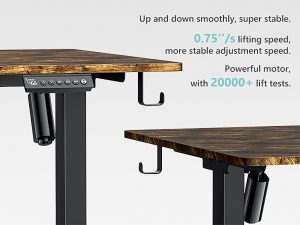In today’s work environment, having an ergonomic setup is crucial. One key component is the height adjustable desk. This versatile desk lets you switch between sitting and standing. This change can promote better posture and improve overall health. In this guide, we will explore how to set up your height adjustable desk effectively. By doing so, you can ensure comfort and boost productivity.
Benefits of a Height Adjustable Desk
Before we dive into the setup, let’s look at the benefits of a height adjustable desk. Research shows that sitting for long periods can lead to health problems. These include back pain, obesity, and heart disease. By using a height adjustable desk, you can easily alternate between sitting and standing. This practice helps reduce these risks.
Additionally, standing while working can increase your energy levels and improve your mood. It also enhances focus. This flexibility creates a more dynamic working experience. Overall, it contributes to better well-being.
 Finding the Right Height
Finding the Right Height
The first step in setting up your height adjustable desk is to find the right height for sitting and standing.
1. Sitting Height: When seated, your elbows should be at a 90-degree angle. Your feet should rest flat on the floor, and your knees should be slightly lower than your hips. Adjust the desk height so your forearms are parallel to the floor when typing. This alignment reduces strain on your shoulders and neck.
2. Standing Height: For standing, the desk should be at or just below elbow height. Your wrists should remain straight while typing. Your hands should hover comfortably above the keyboard. Again, ensure your feet are flat on the ground, with slightly bent knees.
Positioning Your Monitor
Next, consider the placement of your monitor. Proper positioning is key to reducing eye strain and promoting good posture.
– Eye Level: The top of your monitor should be at or just below eye level. This position allows you to look slightly down at the screen, minimizing neck strain.
– Distance: Your monitor should be about an arm’s length away. This distance helps reduce eye fatigue and allows for comfortable reading.
– Angle: Tilt the monitor slightly backward (10 to 20 degrees) to reduce glare and create a more natural line of sight.
Organizing Your Workspace
A tidy workspace is essential for maintaining focus. Here are some tips for organizing your height adjustable desk:
– Keyboard and Mouse: Place your keyboard and mouse close to each other to avoid reaching too far. Ensure they are at the same height as your elbows when seated or standing.
– Document Holder: If you refer to documents while typing, use a document holder. Place it at the same height as your monitor. This helps keep your neck in a neutral position.
– Cable Management: Keep cables organized to avoid distractions. Use clips or ties to bundle cords and prevent tangling.
Remember to Move
Even with a great setup, it’s essential to take breaks and move. Standing for long periods can also cause discomfort. Aim to alternate between sitting and standing every 30 to 60 minutes. Incorporate short walks or stretches to keep your muscles engaged and your blood flowing.
Personalizing Your Setup
Everyone’s body is different. It’s important to customize your height adjustable desk setup. Experiment with various heights and positions to find what feels best for you. If you stand for long periods, consider using an anti-fatigue mat. This mat can help reduce discomfort in your feet and legs.
Conclusion
Setting up a height adjustable desk ergonomically is vital for a healthy workspace. By adjusting the desk height correctly, positioning your monitor well, and organizing your workspace, you can lower the risk of discomfort and health issues. Remember to take regular breaks and personalize your setup to fit your needs.
Incorporating these practices into your routine can transform your work experience. It can make your day more enjoyable and less taxing on your body. Embrace the versatility of a height adjustable desk and enjoy the benefits it brings to your work life.


 Finding the Right Height
Finding the Right Height